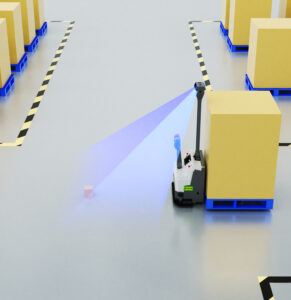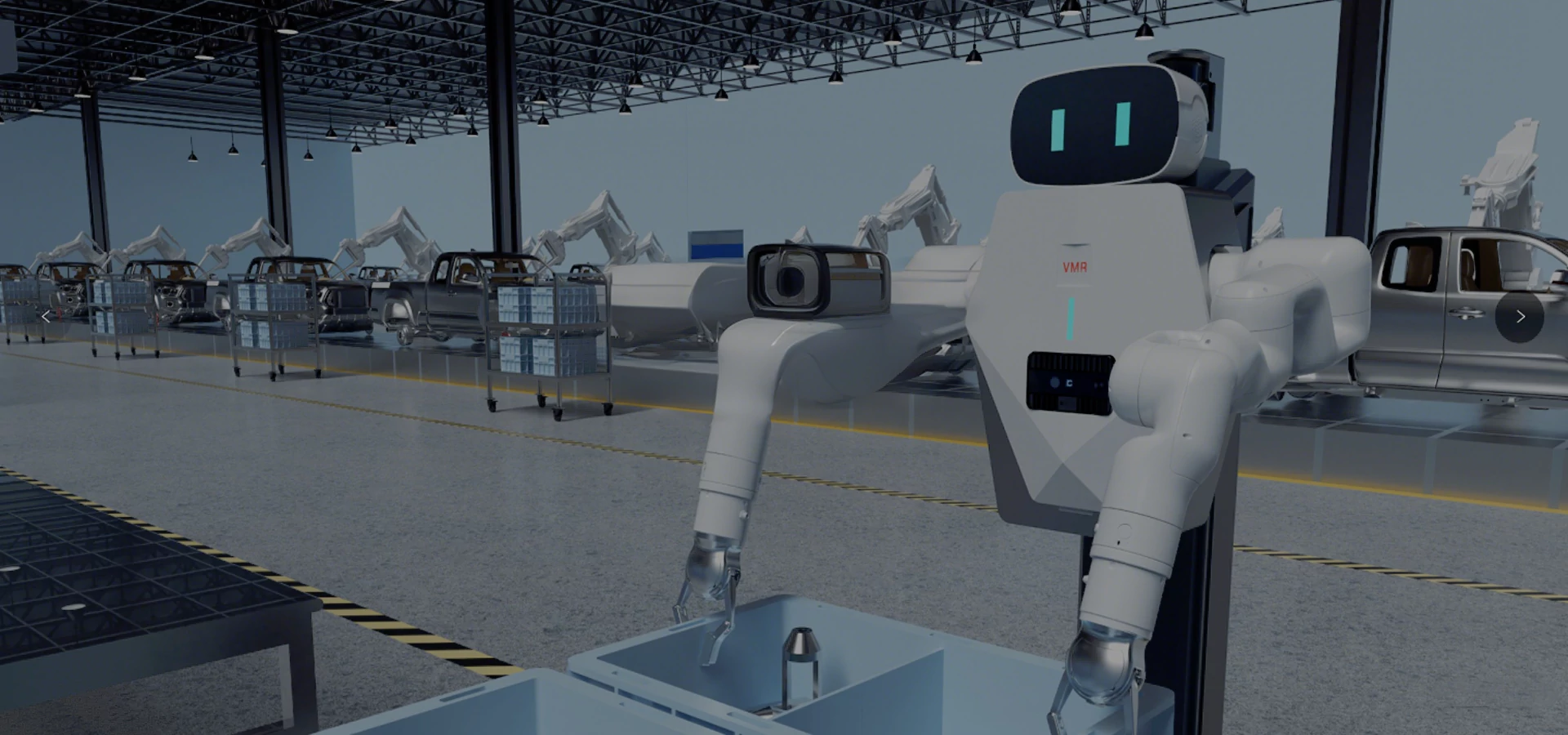Imagine a robot navigating a busy warehouse without stopping or crashing into obstacles — all in real time. This is the power of real-time obstacle avoidance, enabling mobile robots to move quickly and safely in complex environments.
MRDVS leads the way with advanced depth sensing cameras and smart vision tech, giving robots the instant awareness they need. Let’s explore how real-time obstacle avoidance solutions from MRDVS are revolutionizing mobile robotics.
What is Real-Time Obstacle Avoidance?
Real-time obstacle avoidance refers to a robot’s ability to detect and react to obstacles immediately as it moves through its environment. Unlike traditional methods that require the robot to stop and scan, real-time systems continuously process sensor data to navigate smoothly and safely without interruptions.
This capability relies on advanced sensors—such as ultrasonic sensors, LIDAR, and depth cameras—that provide accurate, up-to-date information about the robot’s surroundings. The data is processed using algorithms that help the robot identify obstacles, predict potential collisions, and adjust its path instantly.
By enabling continuous movement and quick decision-making, real-time obstacle avoidance is essential for mobile robots operating in dynamic, unpredictable environments—whether indoors navigating crowded warehouses or outdoors traversing uneven terrain.
Obstacle Avoidance in Indoor Robots
Indoor environments present unique challenges for mobile robots, including cluttered spaces, tight corridors, and moving obstacles such as people. To navigate effectively, indoor robots rely on advanced obstacle avoidance systems that combine precise sensing and intelligent processing.
-
Common Sensors: Ultrasonic sensors are widely used indoors to measure distances by emitting sound waves and detecting echoes. LIDAR sensors create detailed 3D maps by scanning the environment with laser beams, providing precise spatial information. RGB-D depth cameras capture both color and depth data, giving robots a rich understanding of their surroundings for more accurate obstacle detection.
-
Typical Obstacles: Indoor robots must contend with a variety of obstacles such as furniture, shelving units, and equipment that can block their paths. Navigating narrow pathways and doorways requires careful maneuvering to avoid collisions. Additionally, moving obstacles like humans and other robots introduce unpredictability, requiring fast and reliable obstacle avoidance.
-
Techniques to Handle Sensor Limitations: Sensors can sometimes produce noisy or inaccurate data due to reflections, interference, or environmental factors. To address this, certainty grids are used to represent obstacles with varying confidence levels, allowing the robot to filter out unreliable readings and maintain a dependable map of obstacles. Continuous sensor sampling further enhances accuracy by updating obstacle information in real time as the robot moves.
-
Advanced Algorithms: The Virtual Force Field (VFF) algorithm is a popular method that treats obstacles as virtual forces pushing the robot away, helping it navigate smoothly without stopping. This approach allows robots to respond continuously to dynamic environments. Additionally, integration with SLAM (Simultaneous Localization and Mapping) systems enables robots to build and update detailed maps of indoor spaces, improving path planning and obstacle avoidance.
Obstacle Avoidance in Outdoor Robots
Operating in outdoor environments introduces unique challenges for mobile robots. These settings are more unpredictable and varied than indoor spaces, requiring sophisticated obstacle avoidance solutions to ensure safety and efficiency.
-
Diverse Sensor Technologies: Outdoor robots typically use a combination of GPS for precise global positioning, radar systems to detect objects at long distances, and stereoscopic or depth cameras to capture detailed 3D information. These sensors are designed to handle varying lighting and weather conditions like rain, fog, or direct sunlight, which can affect sensor accuracy.
-
Wide Range of Obstacles: Outdoor obstacles range from static objects such as trees, rocks, and curbs to dynamic ones like vehicles, bicycles, and pedestrians. This diversity demands that robots constantly analyze their surroundings and adjust their paths in real time to avoid collisions.
-
Environmental Challenges: Unlike controlled indoor spaces, outdoor environments feature uneven terrain, slopes, and surface irregularities that robots must navigate. Weather conditions such as wind, rain, and dust further complicate obstacle detection and movement, requiring robust sensor calibration and adaptive algorithms.
-
Sensor Fusion and Data Integration: To overcome the limitations of individual sensors, outdoor robots use sensor fusion techniques, combining data from GPS, radar, cameras, and others to form a comprehensive and accurate environmental model. This multi-source data integration enhances obstacle detection reliability and decision-making.
-
Advanced Navigation Algorithms: Obstacle avoidance algorithms for outdoor robots are designed to work seamlessly with SLAM and path planning systems. These algorithms process fused sensor data in real time, enabling the robot to plan safe and efficient routes around obstacles while adapting to changing terrain and unexpected objects.

Challenges in Real-Time Obstacle Avoidance Across Environments
Real-time obstacle avoidance is crucial for mobile robots, but implementing it effectively involves overcoming several challenges that vary across indoor and outdoor environments. These challenges impact how accurately and quickly a robot can detect and react to obstacles.
-
Sensor Limitations and Noise: Sensors such as ultrasonic devices, LIDAR, and cameras often produce noisy or inaccurate data due to reflections, interference, or environmental conditions. For example, ultrasonic sensors may suffer from specular reflections causing missed detections, while cameras can struggle in low light or glare. These inaccuracies complicate reliable obstacle detection and require sophisticated filtering and data fusion techniques.
-
Dynamic and Unpredictable Obstacles: Both indoor and outdoor robots must deal with moving obstacles, such as people indoors or vehicles outdoors. Predicting the movement of these obstacles and adjusting paths in real time is challenging, especially when sensor data updates rapidly or is incomplete.
-
Environmental Factors: Indoor spaces can have cluttered layouts with narrow passages, while outdoor environments include uneven terrain, changing weather, and lighting conditions. These factors affect sensor performance and the robot’s ability to perceive and navigate safely.
-
Computational Demands: Real-time processing of sensor data, running complex algorithms like the Virtual Force Field or SLAM, and making split-second navigation decisions require significant computing power. Balancing this processing with power efficiency and hardware limitations is an ongoing challenge.
-
Integration with Navigation Systems: Obstacle avoidance must work seamlessly with localization and path planning systems. Inaccurate localization or delayed communication between modules can lead to suboptimal decisions or collisions.
How MRDVS Leads the Way in Real-Time Obstacle Avoidance Technology
MRDVS is at the forefront of advancing real-time obstacle avoidance, providing mobile robots with the vision and intelligence needed to navigate complex environments safely and efficiently. Here’s how MRDVS stands out:
Cutting-Edge Depth Sensing Cameras
MRDVS develops high-precision depth sensing cameras that deliver accurate, real-time 3D data. These cameras capture detailed spatial information, allowing robots to detect obstacles with remarkable accuracy—even in challenging lighting or cluttered environments. The advanced sensors minimize blind spots and improve overall perception reliability.
Advanced Sensor Fusion and Data Processing
MRDVS integrates data from multiple sensors seamlessly, combining depth cameras, RGB imaging, and other inputs to create a comprehensive environmental model. This sensor fusion approach helps filter out noise and inaccuracies, ensuring that the obstacle avoidance algorithms work with clean, reliable data.
Optimized Real-Time Algorithms
MRDVS designs and implements efficient algorithms optimized for real-time processing. These algorithms analyze sensor data rapidly, enabling mobile robots to react instantly to dynamic obstacles without the need to stop. This capability is critical for maintaining smooth navigation and preventing collisions.
Versatility for Indoor and Outdoor Use
MRDVS solutions are designed to perform robustly in both indoor and outdoor environments. Whether navigating a cluttered warehouse or an uneven outdoor terrain, MRDVS cameras and algorithms adapt to diverse conditions—handling varying light, weather, and obstacle types.
Seamless Integration with SLAM and Navigation Systems
MRDVS products are fully compatible with popular SLAM and navigation frameworks. This integration allows robots to combine real-time obstacle avoidance with precise localization and path planning, resulting in smarter and more autonomous navigation.
Conclusion
Real-time obstacle avoidance is essential for mobile robots to navigate safely and efficiently in complex environments. MRDVS leads the industry with advanced depth sensing cameras and intelligent algorithms that provide precise, reliable obstacle detection. By integrating MRDVS solutions, you can enhance your robots’ performance and safety in both indoor and outdoor settings. Discover how MRDVS can help you achieve seamless, real-time navigation—contact us today to learn more.


